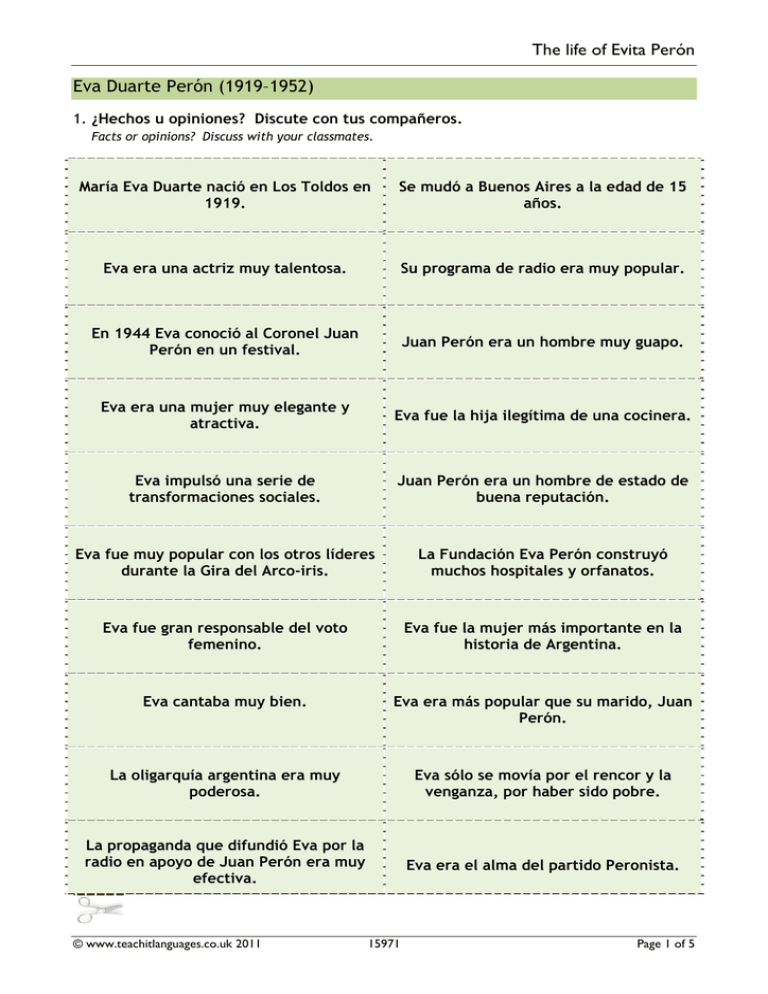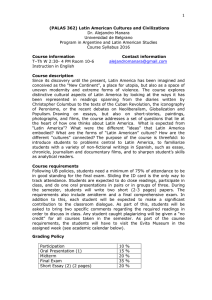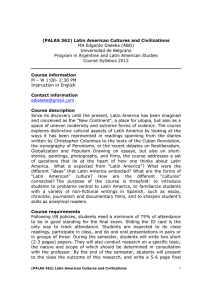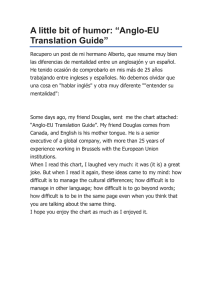The life of Evita Perón Eva Duarte Perón (1919
Anuncio

The life of Evita Perón Eva Duarte Perón (1919–1952) 1. ¿Hechos u opiniones? Discute con tus compañeros. Facts or opinions? Discuss with your classmates. María Eva Duarte nació en Los Toldos en 1919. Se mudó a Buenos Aires a la edad de 15 años. Eva era una actriz muy talentosa. Su programa de radio era muy popular. En 1944 Eva conoció al Coronel Juan Perón en un festival. Juan Perón era un hombre muy guapo. Eva era una mujer muy elegante y atractiva. Eva fue la hija ilegítima de una cocinera. Eva impulsó una serie de transformaciones sociales. Juan Perón era un hombre de estado de buena reputación. Eva fue muy popular con los otros líderes durante la Gira del Arco-iris. La Fundación Eva Perón construyó muchos hospitales y orfanatos. Eva fue gran responsable del voto femenino. Eva fue la mujer más importante en la historia de Argentina. Eva cantaba muy bien. Eva era más popular que su marido, Juan Perón. La oligarquía argentina era muy poderosa. Eva sólo se movía por el rencor y la venganza, por haber sido pobre. La propaganda que difundió Eva por la radio en apoyo de Juan Perón era muy efectiva. Eva era el alma del partido Peronista. © www.teachitlanguages.co.uk 2011 15971 Page 1 of 5 The life of Evita Perón 2. Living graph activity – part 1 This is a sequencing activity. Rearrange the cards into the correct chronological sequence. Cuando Eva tenía un año, su padre abandonó a su madre y regresó a su familia legítima. A la edad de dieciséis años, Eva se trasladó a Buenos Aires porque quería ser actriz. Tres años después de llegar a Buenos Aires, Eva se había establecido con mucho éxito como actriz. Cuatro años más tarde, Eva compró su propio piso en Recoleta, un barrio muy elegante de Buenos Aires. Un año después de comprar el piso, ganaba el sueldo más alto de todas las actrices. A la edad de veinticinco años, Eva encontró a Juan Perón a una función de gala para recaudar fondos para las víctimas de un terremoto. Eva empezó a vivir con Perón, lo que escandalizó a unos miembros de su círculo íntimo. Un año después de encontrar a Eva, Juan Perón fue detenido por el gobierno, que temía su popularidad entre la gente pobre. Después de una manifestación, fue liberado. El año después de su liberación, Perón, con la ayuda de su esposa Eva, se hizo presidente de Argentina. Un año después de la elección de Perón, Eva hizo una gira por Europa. Se encontró con unos líderes importantes como Francisco Franco y Charles de Gaulle. La prensa llamó su viaje « La Gira del Arco-iris ». Eva parecía cansada de vez en cuando. Tres años después de La Gira del Arco-iris, Eva intentó solicitar la nominación de vicepresidente, lo que enojó a los miembros de las fuerzas armadas. Al final, Eva renunció su ambición de ser vicepresidente, por razones de salud. A la edad de treinta y dos años, le diagnosticaron un cáncer del cuello del útero. © www.teachitlanguages.co.uk 2011 15971 Page 2 of 5 The life of Evita Perón Living graph activity – part 2 Read the statements and then in your group plot Evita’s emotional state along the timeline of her life, according to what you think her emotional state might have been at that time. You will have to present your findings to the class. 10 9 8 7 6 5 4 3 2 1 -1 -2 -3 -4 -5 -6 -7 -8 -9 -10 1920 1935 1938 1942 1943 1944 1945 1946 1947 1950 1951 3. ¿Cómo era Evita Perón? Subraya los adjetivos que, en tu opinión, más convengan y discútelo con tu compañero: What was Evita Perón like? Underline the adjectives which in your opinion best suit and discuss this with your partner. ambiciosa simpática poderosa talentosa guapa popular elegante dinámica fea famosa pobre amable optimista inteligente deprimida tímida agresiva jactanciosa arrogante humilde © www.teachitlanguages.co.uk 2011 15971 Page 3 of 5 The life of Evita Perón 4. Escribe sobre la vida de Eva Perón utilizando los principios de las frases y unas palabras útiles para ayudarte. Write an account of Eva Perón’s life using the sentence starters and useful words to help you. Palabras útiles Nació … Junín Cuando tenía dieciséis años … trasladarse actriz Trabajaba como … sueldo Encontró a … función recaudar terremoto Su marido … detener popular liberar presidente En 1947 Eva … gira líderes Durante la gira parecía … enfermo cansado Quería hacerse … vicepresidente fuerzas armadas salud En 1952 … morir cáncer © www.teachitlanguages.co.uk 2011 15971 Page 4 of 5 The life of Evita Perón Teaching notes This unit of learning uses the life story of Evita Perón as the basis for some thinking skills activities. Participants will have an opportunity to engage in fact or opinion work, and sequencing and living graph activities as well as exploring how to introduce the language of disputation into students’ oral exchanges. It would be beneficial to set research homework before embarking upon this unit, so that students can find out about her life and look at photos of her in preparation for the lesson. Alternatively, you could show them photos prior to starting the unit. 1. Print the ‘Hechos u opiniones’ information on card and cut up. Give a set of cards to each pair or trio. Allow sufficient time for them to process the information and discuss as they sort the cards into fact or opinion. In order to help them to discuss, they could use the ‘Spanish toolkit’ worksheet, which is to be found on the Teachit Languages site. 2. Print the statements on card and cut up. Give one set of cards to each group. The first task is a sequencing activity – can they rearrange the cards into the correct chronological sequence? 2.2.1 Next, give out the graph sheets (this might work better printed on A3), one per group. The task here is to plot Evita’s emotional state along the timeline of her life according to the information contained in the statements. Students have to use the information to infer what her emotional state might have been. They discuss the information and put a dot or a cross against a score on the vertical axis for each date. When they reach the end they join up the dots to form the graph. 2.2.2 The debrief consists of each group presenting its graph to the class. This may have to be done in English in the first instance, but the initial reduction in target language will be compensated for by the higher order skills used in the activity, and the amount of text handled by the students. The students could perhaps use the ‘Spanish toolkit’ sheet to help them present their findings in Spanish. The teacher’s role is to highlight the differences between the graphs – it would be most unlikely for groups to produce identical graphs – and explore the reasoning behind the choices. This helps students reflect on their thinking processes. 3. Students look at the adjectives and underline/circle/highlight/tick as many of them as they deem appropriate. 4. As a follow-up activity students could write an account of the life of Evita using the writing frame provided based upon their findings so far. The more able could be encouraged to do further research on the Internet to gain more detail about her life. © www.teachitlanguages.co.uk 2011 15971 Page 5 of 5



